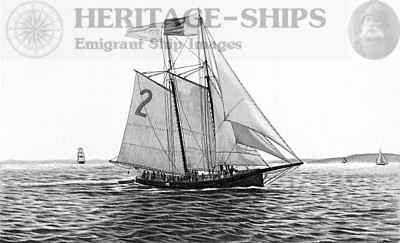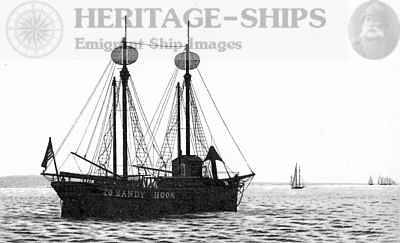The transatlantic passage by Norddeutscher Lloyd steamers, Bremen - Southampton - New York.
October 19, 2009 - Børge Solem
GENERAL INFORMATION GIVEN TO PASSENGERS 1888-89:
Time. — Between Bremen and New York, about nine days ; between Southampton and New York, about seven and a half days.
Departures. — From Bremen, every Wednesday and Saturday ; from Southampton, every Thursday and Sunday ; from New York, every Wednesday and Saturday. Passengers from London: special train at 12.25 p.m. from Waterloo station, on sailing-day. This train will take them alongside the tender which is in waiting to convey them on board the steamer.
Fares. — Dependent on the season of the year and on the size and position of the cabins. The prices of passage from Southampton (1888-89), Main Saloon (from August 1st to October 31st),£20 10s., £23, £24 After Saloon, £11 and £13 10s., Single ; £19 and £21 10s., Return. From November 1st to July 31st, Main Saloon, £14, £16 10s., £18, £23 After Saloon, £10. From Bremen: about £1 10s. more than the foregoing in all cases.
Return Tickets. — For first-class passengers no reduction made.
Children: from one to twelve years of age: half-fare, and, if necessary, two share the same bed. Children under one year: ten shillings.
Servants: taken in the second-class at second-class fares. If required to accompany their employers in the first-class saloon: fare subject to arrangement. Fare includes: complete board, excepting wine, beer, and spirits. First and second class passengers: provided with all cabin requisites. A duly qualified medical man appointed to each ship. His duty: to render assistance, without payment, to any passenger who may fall ill during the voyage. No charge for medicines supplied. Barber: entitled to remuneration for his services. Passengers strictly forbidden to carry matches, gunpowder, or other dangerous substances. Fire-arms to be given into the charge of the captain during the journey.
Smoking: forbidden in every part of the ship except in the smoking-rooms and on deck.
"No passenger may bring wine, beer, or spirituous liquors. These can be procured on board at a fixed tariff-price. The Directors reserve the right of forwarding passengers by any other steamer of their line, to start at the same time, instead of the vessel named on the ticket. On the day fixed for departure, passengers are conveyed free from Bremen to Bremerhaven, and on board the steamer.
Berths may be retained by a deposit at the following rates : 100 marks for every first-class passenger, 50 marks for second-class passengers, and 30 marks for every steerage passenger. When deposit-money is sent it is necessary that the name of the ship and the date of sailing should be distinctly given. Passage-tickets not transferable.

Steerage passengers on the deck of a North German Lloyd steamship
THE VOYAGE FROM BREMEN.
Passengers were conveyed by special train the short run from Bremen to the docks at Bremerhaven. The railway-station was but a few steps from the pier, and passengers walked on board the tender, while the Company's porters were shipping the baggage. The steamers waited not far off the mouth of the river. Passengers who embarked at Bremerhaven enjoyed a twenty-five hours' run between that port and Southampton.THE VOYAGE FROM LONDON.
Passengers from London left Waterloo Station by special train at 12.25 p.m.THE VOYAGE FROM SOUTHAMPTON
The railway voyage between London and Southampton was eighty miles. The special train conveying passengers to the Norddeutscher Lloyd steamers ran direct from Waterloo Station on to the quay alongside the tenders. The baggage was taken care of the Company all the way. The passenger would usually step from train to tender, and from tender to the deck of the steamer. After an hour of sailing the steamers usually reached the Needles, thence followed the coast line past Prawle Point. When reaching the Bishop's Rock off Scilly the steamship headed out to the ocean. For six days the only sights beyond the ship were normally offered by occasional passing vessels.
pilot boat number 2 off New York.
Support Norway Heritage: Purchase a copy
As the ships approached longitude 70° the pilot cutter was watched for. These cutters cruised out as far as the Nantucket Light Ship, sometimes even so far as 400 miles from Sandy Hook. When the pilot was taken aboard he would usually bring the latest intelligence in the shape of New York newspapers. The Western Hemisphere was usually sighted at Fire Island, about three hours after exchanging signals with the Fire Island Light Ship. Then the Sandy Hook and the Scotland Light Ships were passed in turn. Between the latter and Sandy Hook the steamers had to anchor if the tide was unfavorable, and there was not enough water on the bar.

Lightship number 20 located at the barrier spit which encloses the southern entrance of Lower New York Bay south of New York City
Sandy Hook was respectively the termination and commencement of the transatlantic run, the point at which record times began and ended being the starting-point and goal of the most important speed competitions between the great liners. The ships would rather steam round rather than past this famous point, and was carefully piloted through the sand-banks of the Lower Bay to the Quarantine Station. Every effort was made to reach the Quarantine Station before sunset, as after that time the quarantine officer would not come off to inspect the ship which would then have to anchor till the following morning. After leaving the Quarantine Station, the steamers passed through the Narrows, which were little over a mile wide, and then entered the New York Bay. There the navigable channel was much greater. At Bedle's Island, just south-west of the Battery at the southern point of New York City the ships passed the Statue of Liberty, and then the Hudson was entered. Shortly after entering the Hudson the steamers would reach the Norddeutscher Lloyd's pier at Hoboken. The steerage passengers were transported by ferry to Immigration Processing Center for inspection. (Aug 1, 1855 - April 18, 1890 Castle Gardens, April 19, 1890 - Dec 31, 1891 Barge Office, Jan 1, 1892 - June 13, 1897 Ellis Island, June 14, 1897 - Dec 16, 1900 Barge Office, Dec 17, 1900 - Dec 31, 1924 Ellis Island). Usually only steerage (third class) passengers were processed at Immigration Processing Centers, first and second class passengers were usually processed aboard the ship.
At Hoboken, adjoining the Lloyd piers, were the railway termini, while two ferry routes connect their depot with the central and lower parts of the city on the opposite shore.
